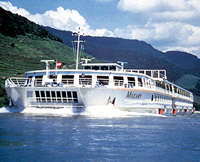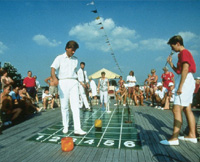|
Pausing
to admire the view from the top of the hill, I took
in a decidedly landlocked scene that seemed incongruous
with the cruise concept. Around me were ruins of a castle
where Richard the Lionhearted was imprisoned, while
below was the Austrian town of Durnstein stretched attractively
along a winding river. In all directions I could see
rolling green hills and lush farmlands in a green and
bucolic scene, and right in the middle of it all, far
from any oceans, was my docked ship.
 |
Having
done extensive ocean cruising but no European river
cruises, I decided to try a week on the Danube River
onboard Peter Deilmann's ms Mozart. River cruises have
always been a popular but more hidden type of cruising,
and with several options now available, I decided it
was time to sample one and find out what to expect.
Would I grow tired of visiting port after port, sometimes
with two in one day, without a relaxing sea day and
would I find the same shipboard ambiance that I relish
on larger, more conventional cruise ships? Happily,
I found the Mozart not only a great way to tour the
countries but also a delightful way to travel with many
similarities to ocean cruises.
A
river cruise in Europe is just as much about the ports
as about the ship, and I chose to sail roundtrip from
Passau, Germany all the way to Budapest, Hungary and
back. The itinerary was a pleasant mix of big cities
(Budapest and Vienna) while also visiting smaller towns
such as Durnstein and Estergom, Hungary that I might
otherwise have missed. We passed through four countries
- Germany, Austria, Hungary and Slovakia - and were
able to see sharp distinctions between such geographically
close countries. Other itineraries stretch throughout
Europe to virtually any country you want, with cruises
sailing in Spain, France, or Italy and longer itineraries
stretching all the way from Holland to Romania on the
Black Sea.
On
my cruise, I traveled only a matter of days after Hungary
and Slovakia joined the E.U and I took particular interest
in the contrast between orderly and prosperous Austria
with developing Hungary, which seemed poorer but yet
making significant progress. Most surprising, however,
was Bratislava, Slovakia, whose name conjured images
in my head of a repressed and dark formerly Communist
country. Despite a massive Communist housing block dominating
the other side of the river, I found the city to be
extremely attractive and full of vibrant life.
Because
the Mozart always tied up in the center of town, all
the attractions on shore were within walking distance,
as is common on virtually all river cruises. (The one
exception on my trip was Vienna, where a convenient
subway ride or short cab ride was necessary to get to
downtown.) With the ports so accessible by foot, I almost
always explored the towns on my own, happily passing
on the organized shore excursions in favor of seeking
out hidden cafes and reveling in tangible European history.
 |
When
cruising on the river, I would sit on the sun deck and
watch passing farm country or charming villages where
ruined castles would suddenly appear from behind a bend.
Complete with comfortable deck chairs and blankets,
along with a shuffleboard court and a giant-sized chessboard,
the top deck was a pleasant and social spot to listen
to onboard commentary about the river when cruising.
Most fun was going under bridges, when the clearance
between the bridge and the Mozart became so tight that
the crew had everyone sit down when going underneath
them to prevent a nasty knock on the head. Other bridges
were so low that even the railings and the pilothouse
had to be lowered to deck level in order for us to squeeze
through.
Before you set sail, however, do your homework and know
what you want to see - I found there was little information
other than maps provided by the vessel to guide you
if you wanted to explore on your own. There was little
incentive for the ship, however, as approximately 85%
or more of the passengers all took the shore excursions
offered by Deilmann. While I wish that more information,
such as slide-illustrated talks, were made available
to those wishing to go ashore independently, most of
Deilmann's competitors include shore excursions in their
fare, giving independently-minded travelers less incentive
to strike out on their own.
In
many respects, the Mozart was just like other cruise
ships, except significantly smaller with only 178 passengers.
The flagship of the Peter Deilmann river fleet, the
Mozart set new standards in comfort for riverboats when
built in 1987 and today, while newer riverboats have
matched or exceeded many of its facilities, the Mozart
is still considered one of the most luxurious riverboats
sailing and the quality of her construction and fittings
is readily apparent.
Feeling
much like a small European hotel, the interior manages
to be both intimate as well as spacious, with a dark
rosewood veneer paneling and a central staircase ringed
with black leather couches and adorned with stained
glass overhead. The company's late owner took a strong
interest in his vessels, decorating them with numerous
original paintings from his personal collection and
giving the Mozart an elegant and classical feel throughout.
With
its beam almost twice as wide as the average riverboat,
cabins are unusually spacious at 203 square feet- significantly
larger than the 150 or 125 square feet you'll find on
the competition. All are extremely attractive, with
large bathrooms, ample storage space, a small sitting
area, a large desk, a TV, minibar and a safe. Cabins
on Tamino deck have a large window to watch the river
go by, while the Dorabella deck cabins were identical
except for their two, somewhat smaller windows that
were literally inches above the waterline.
The
roomy public rooms are equally attractive and comfortable,
including a forward observation lounge with floor to
ceiling windows on three sides. During the day, afternoon
tea service was held here, while at night, the room
would be used for local folk entertainment that was
popular and well received, as well as live music for
dancing by the ship's small band. There was little in
terms of nightlife as almost all passengers would be
in their cabins by 11 p.m. in anticipation of the morning
port call.
One
deck below is the fitness center with sauna and massage
facilities, a Jacuzzi and a small pool with enormous
windows in the bow providing a unique view overlooking
the river. Lounges were mostly used for sitting and
talking, as there were really no organized activities
during the few times we were underway during the day
and life onboard was happily low key and quiet. There
were no elevators, however, and with a heavily German
crowd, only the dining room was completely non-smoking.
The
highlight of the ship experience was undoubtedly the
dining. Forget the new trend of Freestyle Dining - with
Deilmann, this is cruising at its most traditional with
breakfast, lunch and dinner all served at the same table
by the same waiter in the ship's elegant and spacious
restaurant.
Breakfast and lunch were a buffet accompanied
by a menu offering more extensive courses. Dinner was
a splendid two-hour affair - meals were seven courses
at a minimum - and artfully prepared with perfect portion
sizes that left you satisfied but not stuffed. We looked
forward to each meal with enthusiasm as the food was
comparable to the oceangoing luxury lines and the mostly
Hungarian staff and German officers were engaging and
thoroughly professional. Service on the Mozart was,
without exception, excellent throughout.
Amongst
the passengers, most are German with English-speaking
passengers usually accounting for only 15 to 25% of
those onboard. While some may find the dual languages
used onboard irritating, I welcomed the more Continental
atmosphere when in Europe and found it somehow more
authentic than traveling with only Americans. Being
so clearly in the minority, there was no doubt we were
Americans on a German oriented vessel, however, as opposed
to sharing an American market ship with Germans. It
mattered little, though, since all crew spoke good English
and separate English shore excursions were arranged,
thereby helping to keep tour group sizes fairly small.
While
Deilmann is often considered among the most luxurious
of the river companies, there are several other companies
that market to Americans. Viking River Cruises operates
the largest fleet of riverboats, with 23 ships sailing
numerous itineraries, including trips in Russia and
China. Most of Viking's ships are new and attractive,
featuring all the latest amenities including sliding
French Balcony doors in many of the cabins. The overall
experience is somewhat more packaged than Deilmann's,
with only Americans onboard and shore excursions in
each port included in the fare. There is less of a European
flair to Vikings ships in everything from the cuisine
to the passengers, and complete with small atriums and
even smaller pools, their ships are a bit jazzier in
décor and more American in ambiance.
Avalon Waterways also offers river cruises and will
soon be operating a total of three ships catering only
to Americans. As with Viking, the onboard experience
is tilted for Americans, including nonsmoking interiors,
"Continental cuisine that appeals to the North
American palate," lectures, included shore excursions
and often packages including pre- and post-cruise hotel
stays. Also sailing in Europe are the River Cloud I
and II, which offer extremely luxurious and classical
cruises that are on par with Deilmann, and Uniworld,
which offers a similar number of itineraries and amenities
as Viking does.
River
cruises tend to be more expensive than the lowest fares
for ocean cruises. My seven-night cruise on the Mozart
was priced at $2,300 in May, not including airfare,
while Viking offers a similar but smaller cabin on a
similar itinerary for around $2,000 including shore
excursions. Avalon's Danube itinerary features seven
nights on the ship and three nights in Budapest and
Prague each for $2,600 for the eleven-night package.
Prices naturally vary by season, and some companies
offer special Christmas sailings.
During
my week on the Danube, I saw more ports in less time
than I would have had I been traveling on land, all
the while enjoying the ample comforts and convenience
of a cruise ship. I was more than won over by this form
of cruising, and when planning my next trip, I may start
with a map of central Europe and its river systems rather
than looking at the oceans and ports along the coast. |